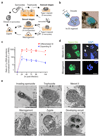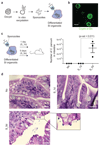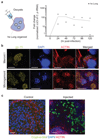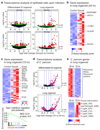Modelling Cryptosporidium infection in human small intestinal and lung organoids
- PMID: 29946163
- PMCID: PMC6027984
- DOI: 10.1038/s41564-018-0177-8
Modelling Cryptosporidium infection in human small intestinal and lung organoids
Abstract
Stem-cell-derived organoids recapitulate in vivo physiology of their original tissues, representing valuable systems to model medical disorders such as infectious diseases. Cryptosporidium, a protozoan parasite, is a leading cause of diarrhoea and a major cause of child mortality worldwide. Drug development requires detailed knowledge of the pathophysiology of Cryptosporidium, but experimental approaches have been hindered by the lack of an optimal in vitro culture system. Here, we show that Cryptosporidium can infect epithelial organoids derived from human small intestine and lung. The parasite propagates within the organoids and completes its complex life cycle. Temporal analysis of the Cryptosporidium transcriptome during organoid infection reveals dynamic regulation of transcripts related to its life cycle. Our study presents organoids as a physiologically relevant in vitro model system to study Cryptosporidium infection.
Conflict of interest statement
N.S. and H.C. are inventors on patents/patent applications related to organoid technology.
Figures




Comment in
-
Organoid hosts for parasitic infection.Nat Methods. 2018 Sep;15(9):652. doi: 10.1038/s41592-018-0129-5. Nat Methods. 2018. PMID: 30171247 No abstract available.
References
-
- Clevers H. Modeling Development and Disease with Organoids. Cell. 2016;165:1586–1597. - PubMed
-
- Sato T, et al. Long-term expansion of epithelial organoids from human colon, adenoma, adenocarcinoma, and Barrett's epithelium. Gastroenterology. 2011;141:1762–1772. - PubMed
-
- Thompson RC, et al. Cryptosporidium and cryptosporidiosis. Advances in parasitology. 2005;59:77–158. - PubMed
-
- Current WL, Garcia LS. Cryptosporidiosis. Clinics in laboratory medicine. 1991;11:873–897. - PubMed
Publication types
MeSH terms
Grants and funding
LinkOut - more resources
Full Text Sources
Other Literature Sources
Medical
Molecular Biology Databases

